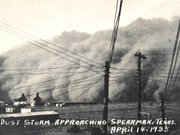Dust Bowl
|
|
Dust_Storm_Texas_1935.jpg
The Dust Bowl was a series of dust storms in the central United States and Canada in the mid to late 1930s, caused by a massive drought and decades of inappropriate farming techniques. The fertile soil of the Great Plains was exposed through removal of grass during plowing. During the drought, the soil dried out, became dust, and blew away. The wind blew the dust to the east in very large black clouds. The clouds made the sky appear black all the way to Chicago. Eventually the soil was completely lost when it blew out to the Atlantic Ocean. Beginning in 1934 and lasting until 1939, this ecological disaster caused an exodus from the Oklahoma Panhandle region and also the surrounding Great Plains in which over 500,000 Americans were homeless.[1] (http://www.pbs.org/fmc/interviews/gregory.htm) Topsoil across millions of acres was blown away because the indigenous sod had been broken for wheat farming and the vast herds of buffalo were no longer fertilizing the rest of the indigenous grasses. It covered parts of Texas, Oklahoma, Colorado, Kansas, and New Mexico.
It is well known that there was economic instability in agriculture during the 1920s, due to overproduction following World War I. National and international market forces during the war had caused farmers to push the agricultural frontier beyond its natural limits. Increasingly, marginal land that would now be considered unsuitable for use was developed to capture profits from the war. After the land had been stripped of its natural vegetation, the ecological balance of the plains was destroyed, leaving nothing to hold the soil when the rains dried up and the winds came in the 1930s.
With their crops ruined, lands barren and dry, and homes foreclosed for unpayable debts, many farm families gave up and left. Many of the displaced were from Oklahoma, where 15% of the state's population left. The migrants were called "Okies," whether or not they were from Oklahoma. High-end estimates for the number of displaced Americans are as high as 2.5 million, but the lower value of 300,000 to 400,000 is more probable based upon the 2.3 million population of Oklahoma at the time.
Dallas_South_Dakota_1936.jpg
On November 11, 1933, a very strong dust storm stripped topsoil from desiccated South Dakota farmlands in just one of a series of disastrous dust storms that year. Then on May 11, 1934, a strong two-day dust storm removed massive amounts of Great Plains topsoil in one of the worst such storms of the Dust Bowl. The dust clouds blew all the way to Chicago where filth fell like snow, dumping the equivalent of four pounds of debris per person on the city. Several days later, the same storm reached cities in the east, such as Buffalo, Boston, New York City, and Washington, D.C.. That winter, red snow fell on New England.
On April 14, 1935 known as "Black Sunday", one of the worst "Black Blizzards" occurred throughout the dustbowl, causing extensive damage, turning the day to night. Witnesses reported that they could not see five feet in front of them at certain points.
During President Franklin D. Roosevelt's first 100 days, governmental programs to restore the ecologic balance of the nation were implemented. The U.S. Government was to form the Soil Conservation Service, now the Natural Resources Conservation Service.
The human crisis was documented by photographers from the Farm Security Administration; among which the most famous was Dorothea Lange.
See also
- Woody Guthrie
- The Grapes of Wrath
- Great Depression
- Rain follows the plow
- The Plow That Broke the Plains
- Timeline of environmental events
Further reading
- The Dust Bowl: Men, Dirt, and Depression, , Paul Bonnifield, University of New Mexico Press, Albuquerque, New Mexico, 1978, hardcover, ISBN 0-8263-0485-0
- Survival in the Storm: The Dust Bowl Diary of Grace Edwards, Dalhart, Texas, 1935, Katelan Janke, Scholastic (September 2002), ISBN 0-4392-1599-4
- The Grapes of Wrath, John Steinbeck, The Viking Press. New YorkFirst Edition, 1939.
External links
- USDA Natural Resources Conservation Service (http://www.nrcs.usda.gov/)
- NASA Explains "Dust Bowl" Drought (http://www.gsfc.nasa.gov/topstory/2004/0319dustbowl.html)
- The Dust Bowl photo collection (http://www.weru.ksu.edu/new_weru/multimedia/dustbowl/dustbowlpics.html)
- The Dust Bowl (http://eh.net/encyclopedia/?article=Cunfer.DustBowl) (EH.Net Encyclopedia)
- Black Sunday, April 14, 1935, Dodge City, KS (http://www.ku.edu/heritage/kshistory/dustbowl.html)

